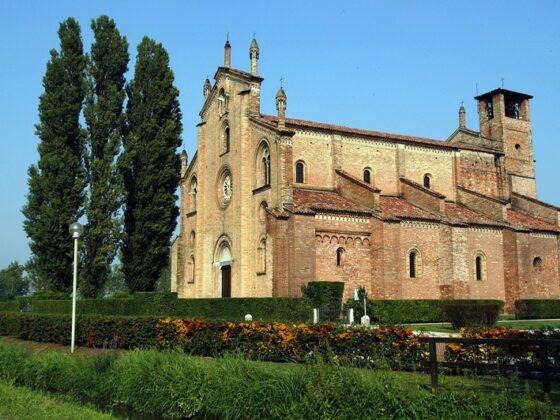22. Basilica of San Bassiano
22. Basilica of San Bassiano
- Telephone: 0371 752900
- Address: Lodi Vecchio
The Basilica of the XII apostles (known as Basilica of San Bassiano after the X century AD) finds its roots in the IV century AD, but in its current structure is stands for on of the most significant examples of medieval architecture in Lombardy with its substantial refurbishment in the first decades of the IV century.
The typically Gothic brickwork façade is parted in three portions with thin pilasters that give it a slender and vertical look; it features several openings, among which are “open” single and double-lancet windows and ports. In the equally divided central part, there is a portal surmounted by a round arch, a rose window, a single-lancet window and an aedicule housing the statue of San Bassiano, a copy of the original preserved in the Lodi Cathedral.
The split gable tympanum and the side ends, surmounted by pinnacles, end with a set of entwined lancet arches, which also adorn the sides. The building still preserves traces of the pre-existing Roman complex, such as the opus spicatum part of a wall around the single lancet window in the first Southern span, a technique used in churches during the Roman age.
The Basilica displays several other frescoes and reliefs, from the XIV century

The Basilica of the XII apostles (known as Basilica of San Bassiano after the X century AD) finds its roots in the IV century AD, but in its current structure is stands for on of the most significant examples of medieval architecture in Lombardy with its substantial refurbishment in the first decades of the IV century.
The typically Gothic brickwork façade is parted in three portions with thin pilasters that give it a slender and vertical look; it features several openings, among which are “open” single and double-lancet windows and ports. In the equally divided central part, there is a portal surmounted by a round arch, a rose window, a single-lancet window and an aedicule housing the statue of San Bassiano, a copy of the original preserved in the Lodi Cathedral.
The split gable tympanum and the side ends, surmounted by pinnacles, end with a set of entwined lancet arches, which also adorn the sides. The building still preserves traces of the pre-existing Roman complex, such as the opus spicatum part of a wall around the single lancet window in the first Southern span, a technique used in churches during the Roman age.
The Basilica displays several other frescoes and reliefs, from the XIV century


